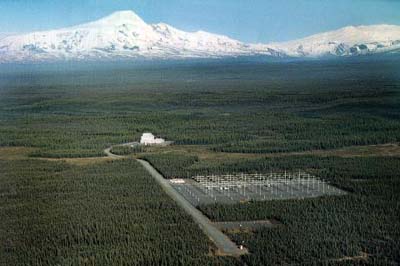
The University of Alaska Fairbanks will take ownership of Gakona’s High Frequency Active Auroral Program, also known as HAARP.
After two bumpy years waiting for the U.S. Air Force to decide what to do with HAARP, the university has won its bid to take over the facility for research purposes.
About a year ago UAF, with the support of scientists around the globe, managed to delay the Air Force’s plan to close and demolish the HAARP compound.
UAF spokeswoman Marmian Grimes says the university will take ownership of the $200 million facility next month.
“It’s a transfer, and next month the facilities and equipment will formally transfer from the military to the university, and then we have two years to work with the Air Force to come to an agreement to transfer land,” Grimes says.
The university must still negotiate with the military for 1,500 acres of land out of the 5,500 acres the Air Force owns in Gakona. The university system is loaning UAF $2 million dollars to get the facility back into operation. Grimes says a plan is in place to raise money to cover the loan and costs associated with operations.
“Scientists would pay to use the facility for their research projects, and that would support operations; that’s a common model for the university and research community,” Grimes says. “The Sikuliaq, which just recently came on board, uses the same sort of model. We use the same model at Poker Flat research range as well. We are also working to identify some anchor tenants to help cover operating costs.”
Head of UAF’s Geophysical Institute, Bob McCoy, has been instrumental in persuading the Air Force to give HAARP to the university.
“The government’s invested about $290 million federal dollars. In the last decade or so, the Navy, the Air Force and DARPA (Defense Advanced Research Projects Agency) all chipped in $40 to $50 million each, and they expanded it and increased the power and made improvements,” McCoy says. “So it really is exquisite. It’s a good catch for the State of Alaska and the University in Fairbanks to get this excellent facility, and both the chancellor and the president both saw that, and were eager to have this added it to our portfolio here.”
HAARP is one of only three similar facilities in the world. One is in Norway and another in Russia. Research into the Earth’s ionosphere was the primary job at HAARP when the Air Force operated it. In June 2013 the military announced research was coming to an end and made known its intention to shutter HAARP.
Last July, HAARP was saved days before bulldozers were ordered to move in. Grimes says scientists rallied to put pressure on the Air Force to scrap the demolition plan.
“National Research Council has been involved, we’ve spoken to the National Science Foundation, as well as a wide variety of scientists regarding the possibility of keeping the facility open and running it as a university facility. We’ve found a lot of support there. The scientific community wants to keep this facility. It’s regarded as the best in the world, more powerful than the other two facilities,” Grimes says.
UAF faculty and graduate students have used HAARP for research over the past few years, and now the university plans to expand programs there. Bob McCoy says HAARP turns the ionosphere into a laboratory.
“There’s a lot of science that can be done. The Navy, in the past, has been interested in using the ionosphere like an antenna to generate extremely low frequency waves to communicate with submarines, even things like creating simulation in the ionosphere to modulate radio waves. There’s a whole bunch of applications,” McCoy says.
HAARP has been beaming radio waves into the atmosphere since 1997 in an effort to understand the ionosphere, which has a strong influence on satellite communications. But its mission is often misunderstood, and has given rise to speculation that its work is linked to top secret military research.
